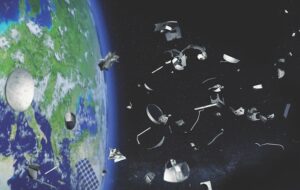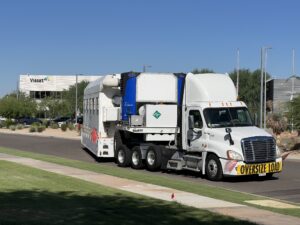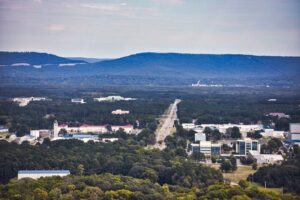Short space trips for paying passengers on the way
Thursday, 14 July 2022 00:42 CAS Space, a Beijing-based rocket company owned by the Chinese Academy of Sciences, is designing a set of reusable rocket and spacecraft, with the aim of sending paying passengers on short trips into space, said the company's chairman.
Yang Yiqiang, a senior rocket scientist and founder of CAS Space, told China Daily in an exclusive interview on Wednesday that if everything goes according
CAS Space, a Beijing-based rocket company owned by the Chinese Academy of Sciences, is designing a set of reusable rocket and spacecraft, with the aim of sending paying passengers on short trips into space, said the company's chairman.
Yang Yiqiang, a senior rocket scientist and founder of CAS Space, told China Daily in an exclusive interview on Wednesday that if everything goes according Skyrora opens UK's largest rocket engine manufacturing facility
Thursday, 14 July 2022 00:42 UK rocket company Skyrora has taken another important stride towards achieving a sovereign orbital launch from British soil by opening a new manufacturing and production facility, the largest of its kind in the UK.
After recently opening its engine test facility in Midlothian, this new facility in Cumbernauld allows the company to concentrate its launch development practices in custom-buil
UK rocket company Skyrora has taken another important stride towards achieving a sovereign orbital launch from British soil by opening a new manufacturing and production facility, the largest of its kind in the UK.
After recently opening its engine test facility in Midlothian, this new facility in Cumbernauld allows the company to concentrate its launch development practices in custom-buil NASA Highlights Climate Research on Cargo Launch, Sets Coverage
Thursday, 14 July 2022 00:42 NASA and SpaceX are targeting 8:44 p.m. EDT Thursday, July 14, to launch the agency's next investigation to monitor climate change to the International Space Station. The mission, NASA's Earth Surface Mineral Dust Source Investigation (EMIT), will fly aboard SpaceX's 25th commercial resupply services mission to the orbital laboratory.
SpaceX's Dragon spacecraft will lift off from Launch Co
NASA and SpaceX are targeting 8:44 p.m. EDT Thursday, July 14, to launch the agency's next investigation to monitor climate change to the International Space Station. The mission, NASA's Earth Surface Mineral Dust Source Investigation (EMIT), will fly aboard SpaceX's 25th commercial resupply services mission to the orbital laboratory.
SpaceX's Dragon spacecraft will lift off from Launch Co Moving Right Along - Sol 3531
Thursday, 14 July 2022 00:42 Since we finished up with our "Avanavero" drill activities yesterday, we're officially back on the Martian road to the layered sulfate-bearing unit! Today we just planned a single sol's worth of activities, and filled the day with contact science, remote sensing, and a 50m+ drive.
The remote sensing and contact science activities include a MAHLI and ChemCam LIBS observation of a bedrock ta
Since we finished up with our "Avanavero" drill activities yesterday, we're officially back on the Martian road to the layered sulfate-bearing unit! Today we just planned a single sol's worth of activities, and filled the day with contact science, remote sensing, and a 50m+ drive.
The remote sensing and contact science activities include a MAHLI and ChemCam LIBS observation of a bedrock ta An ocean of galaxies awaits
Thursday, 14 July 2022 00:42 Sometime around 400 million years after the birth of our universe, the first stars began to form. The universe's so-called dark ages came to an end and a new light-filled era began. More and more galaxies began to take shape and served as factories for churning out new stars, a process that reached a peak about 4 billion years after the Big Bang.
Luckily for astronomers, this bygone era ca
Sometime around 400 million years after the birth of our universe, the first stars began to form. The universe's so-called dark ages came to an end and a new light-filled era began. More and more galaxies began to take shape and served as factories for churning out new stars, a process that reached a peak about 4 billion years after the Big Bang.
Luckily for astronomers, this bygone era ca Astronomers detect a radio "heartbeat" billions of light-years from Earth
Thursday, 14 July 2022 00:42 Astronomers at McGill University, MIT and elsewhere have detected a strange and persistent radio signal from a far-off galaxy, that appears to be flashing with surprising regularity. Classified as a fast radio burst, or FRB, this new signal persists for up to three seconds, about 1,000 times longer than the average FRB. Within this window, the team detected bursts of radio waves that repeat ever
Astronomers at McGill University, MIT and elsewhere have detected a strange and persistent radio signal from a far-off galaxy, that appears to be flashing with surprising regularity. Classified as a fast radio burst, or FRB, this new signal persists for up to three seconds, about 1,000 times longer than the average FRB. Within this window, the team detected bursts of radio waves that repeat ever From "i" for "inspiral" to "g" for "gamma-ray burst"
Thursday, 14 July 2022 00:42 Using supercomputer calculations, scientists at the Max Planck Institute for Gravitational Physics in Potsdam and from Japan show a consistent picture for the first time: They modeled the complete process of the collision of a black hole with a neutron star. In their studies, they calculated the process from the final orbits through the merger to the post-merger phase, in which according to thei
Using supercomputer calculations, scientists at the Max Planck Institute for Gravitational Physics in Potsdam and from Japan show a consistent picture for the first time: They modeled the complete process of the collision of a black hole with a neutron star. In their studies, they calculated the process from the final orbits through the merger to the post-merger phase, in which according to thei New radio astronomy survey peers through cosmic dust to investigate the Milky Way
Thursday, 14 July 2022 00:42 The first results from a mammoth astronomy project aimed at mapping out the origins of our 13.8 billion year old universe have been announced.
An international team of astronomers from around the globe taking part in the project named, COMAP (CO Mapping Array Project) will offer us a new glimpse into this epoch of galaxy assembly, helping to answer questions about what really caused the un
The first results from a mammoth astronomy project aimed at mapping out the origins of our 13.8 billion year old universe have been announced.
An international team of astronomers from around the globe taking part in the project named, COMAP (CO Mapping Array Project) will offer us a new glimpse into this epoch of galaxy assembly, helping to answer questions about what really caused the un ETH researchers remeasure gravitational constant
Thursday, 14 July 2022 00:42 Researchers at ETH Zurich have redetermined the gravitational constant G using a new measurement technique. Although there is still a large degree of uncertainty regarding this value, the new method offers great potential for testing one of the most fundamental laws of nature.
The gravitational constant G determines the strength of gravity - the force that makes apples fall to the ground o
Researchers at ETH Zurich have redetermined the gravitational constant G using a new measurement technique. Although there is still a large degree of uncertainty regarding this value, the new method offers great potential for testing one of the most fundamental laws of nature.
The gravitational constant G determines the strength of gravity - the force that makes apples fall to the ground o Office of Space Commerce to start developing architecture for traffic management
Wednesday, 13 July 2022 21:46
Chirag Parikh, executive secretary of the National Space Council, said he expects the Office of Space Commerce to start developing an architecture for space traffic management, an initiative that has been bogged down by studies and lack of funding.
Second ViaSat-3 payload arrives in California for integration
Wednesday, 13 July 2022 19:30
The payload for Viasat’s second ViaSat-3 broadband satellite has arrived in California to be integrated with a Boeing chassis, the operator said July 13.
The post Second ViaSat-3 payload arrives in California for integration appeared first on SpaceNews.
Air Force completes draft environmental review of U.S. Space Command candidate locations
Wednesday, 13 July 2022 18:08
A draft environmental assessment said the proposed relocation of U.S. Space Command to Redstone Arsenal, Alabama, would have “no significant impacts on the human or natural environment.”
The post Air Force completes draft environmental review of U.S.
Highlights of the inaugural Vega-C launch
Wednesday, 13 July 2022 17:25 Video:
00:02:35
Video:
00:02:35
ESA’s newest launch system has faced its first full validation test, carrying LARES-2, a scientific mission of the Italian space agency ASI, and a secondary payload package of French, Italian and Slovenian research CubeSats.
Space weather will delay your trains
Wednesday, 13 July 2022 17:22
Fluctuations in space weather are disrupting train signals and causing significant delays. A project investigating the effect of solar storms on railway signals will be presented this week at the National Astronomy Meeting (NAM 2022) by Cameron Patterson, a Ph.D. student at Lancaster University.
The sun's tendency to affect technology on Earth, as well as in space, is known as space weather. In railways, electric currents caused to flow in the Earth by solar activity can interfere with the normal operation of signals, turning green signals to red even when there is no train nearby.
Patterson says: "Most of us have at one point heard the dreaded words: 'your train is delayed due to a signaling failure,' and while we usually connect these faults to rain, snow and leaves on the line, you may not have considered that the sun can also cause railway signals to malfunction.
SIRI-2 to qualify technologies for radiation detection in space
Wednesday, 13 July 2022 17:10
U.S. Naval Research Laboratory scientists launched the second Strontium Iodide Radiation Instrument (SIRI-2) instrument in December 2021 onboard Space Test Program (STP) Sat-6. SIRI-2, a gamma-ray spectrometer, will demonstrate the performance of europium-doped strontium iodide gamma ray detection technology with sufficient active area for Department of Defense (DoD) operational needs.
The first SIRI mission was launched Dec.

